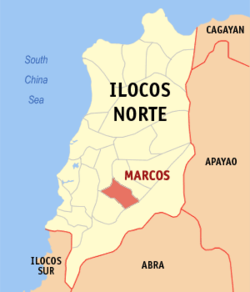
Back Marcos, Ilocos Norte BCL Marcos CBK-ZAM Marcos, Ilocos Norte CEB Marcos (Ilocos Norte) German Marcos (Ilocos Norte) Spanish Marcos (Ilocos Norte) French Marcos, Ilocos Utara ID Marcos, Ilocos Norte ILO Marcos (Ilocos Norte) Italian მარკოსი (ჩრდილოეთი ილოკოსი) Georgian
Marcos | |
|---|---|
| Municipality of Marcos | |
 Map of Ilocos Norte with Marcos highlighted | |
Location within the Philippines | |
| Coordinates: 18°02′40″N 120°40′43″E / 18.0444°N 120.6786°E | |
| Country | Philippines |
| Region | Ilocos Region |
| Province | Ilocos Norte |
| District | 2nd district |
| Founded | June 22, 1963 |
| Named after | Mariano Marcos |
| Barangays | 13 (see Barangays) |
| Government | |
| • Type | Sangguniang Bayan |
| • Mayor | Antonio V. Mariano |
| • Vice Mayor | Hilario B. Lorenzo |
| • Representative | Eugenio Angelo M. Barba |
| • Municipal Council | Members |
| • Electorate | 12,974 voters (2025) |
| Area | |
• Total | 72.77 km2 (28.10 sq mi) |
| Elevation | 82 m (269 ft) |
| Highest elevation | 376 m (1,234 ft) |
| Lowest elevation | 27 m (89 ft) |
| Population (2020 census)[3] | |
• Total | 18,010 |
| • Density | 250/km2 (640/sq mi) |
| • Households | 4,675 |
| Economy | |
| • Income class | 4th municipal income class |
| • Poverty incidence | 8.04 |
| • Revenue | ₱ 231.8 million (2022) |
| • Assets | ₱ 924.9 million (2022) |
| • Expenditure | ₱ 150.8 million (2022) |
| • Liabilities | ₱ 257.4 million (2022) |
| Service provider | |
| • Electricity | Ilocos Norte Electric Cooperative (INEC) |
| Time zone | UTC+8 (PST) |
| ZIP code | 2907 |
| PSGC | |
| IDD : area code | +63 (0)77 |
| Native languages | Ilocano Tagalog |
Marcos, officially the Municipality of Marcos (Ilocano: Ili ti Marcos; Filipino: Bayan ng Marcos), is a municipality in the province of Ilocos Norte, Philippines. According to the 2020 census, it has a population of 18,010.[3]
Formerly a part of Dingras, Ilocos Norte, Marcos was established on June 22, 1963 by virtue of Republic Act No. 3753. The town's namesake is Don Mariano Marcos, the father of former President Ferdinand Marcos and the grandfather of current president Bongbong Marcos.
Marcos is 29 kilometres (18 mi) from Laoag, 510 kilometres (320 mi) from Manila, 79 kilometres (49 mi) from Bangued, and 28 kilometres (17 mi) from Batac.
- ^ Municipality of Marcos | (DILG)
- ^ "2015 Census of Population, Report No. 3 – Population, Land Area, and Population Density" (PDF). Philippine Statistics Authority. Quezon City, Philippines. August 2016. ISSN 0117-1453. Archived (PDF) from the original on May 25, 2021. Retrieved July 16, 2021.
- ^ a b Census of Population (2020). "Region I (Ilocos Region)". Total Population by Province, City, Municipality and Barangay. Philippine Statistics Authority. Retrieved 8 July 2021.
- ^ "PSA Releases the 2021 City and Municipal Level Poverty Estimates". Philippine Statistics Authority. 2 April 2024. Retrieved 28 April 2024.
© MMXXIII Rich X Search. We shall prevail. All rights reserved. Rich X Search



